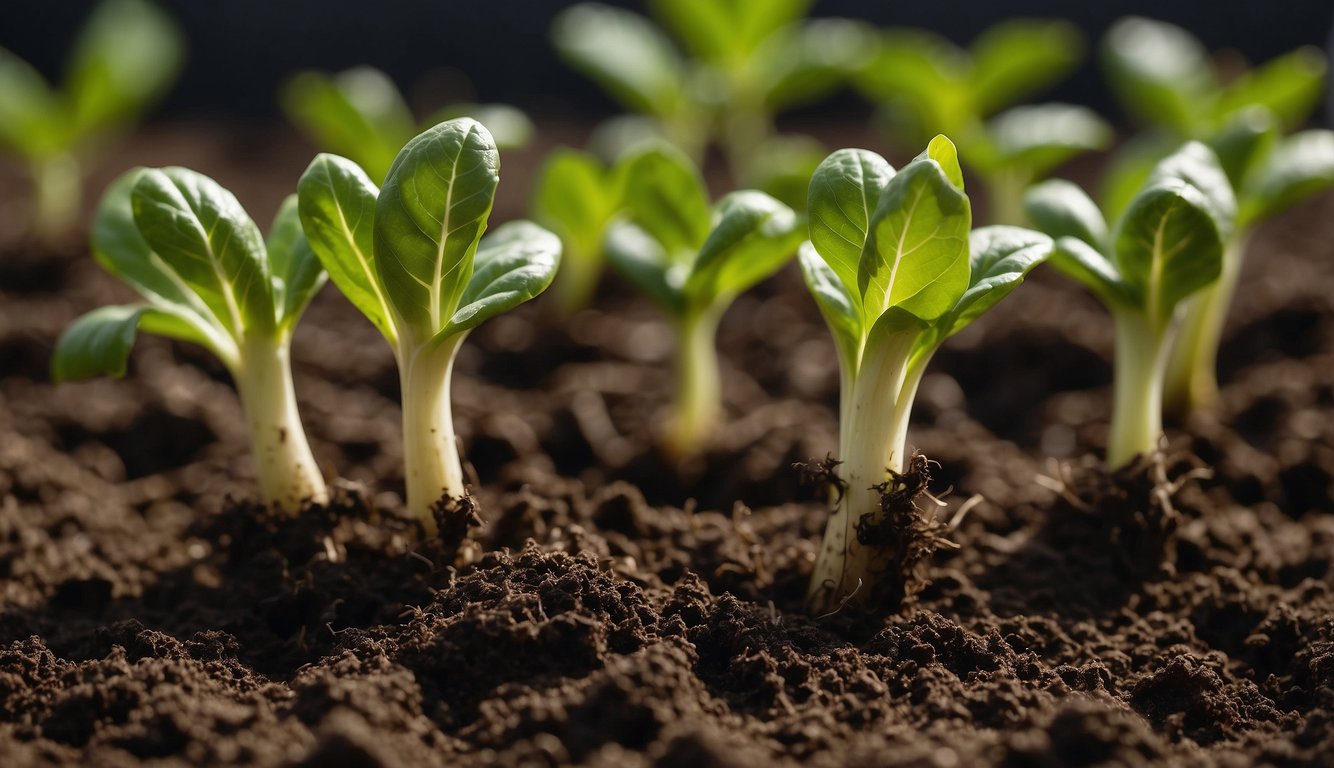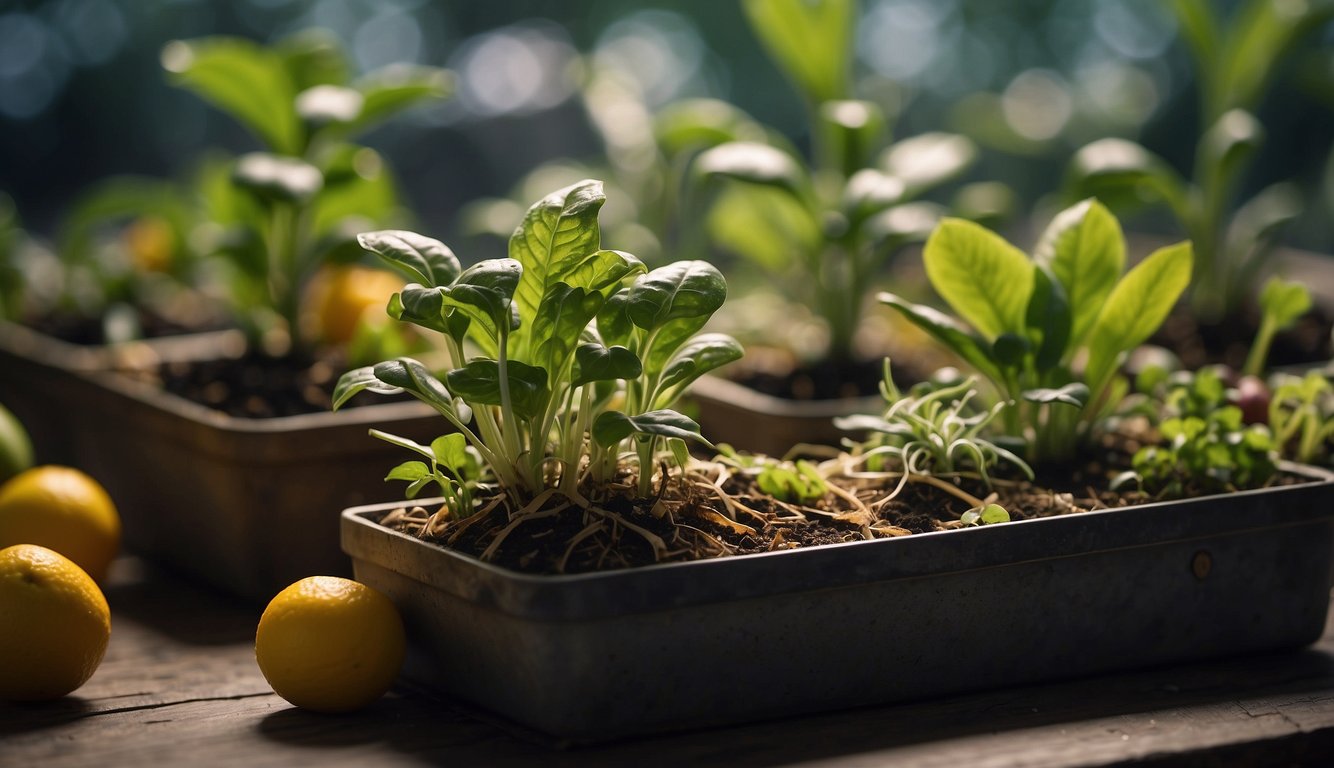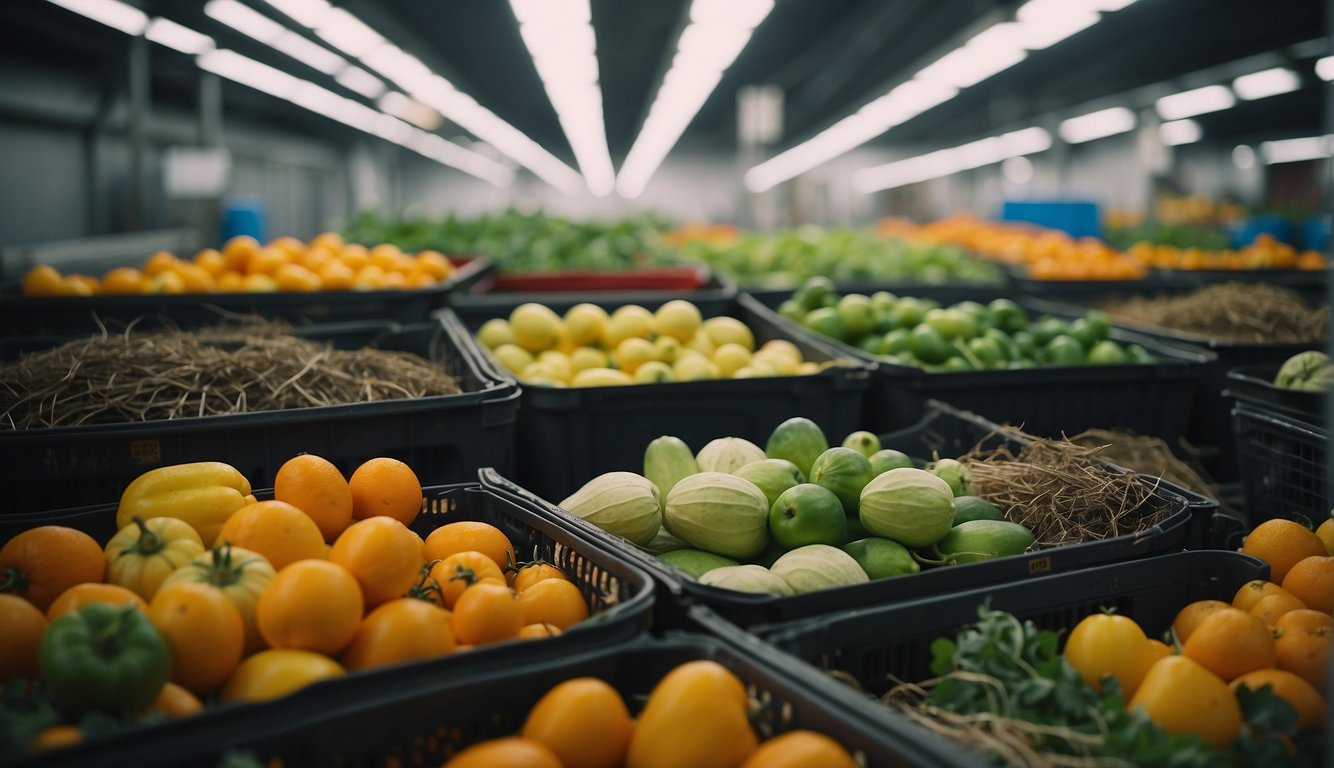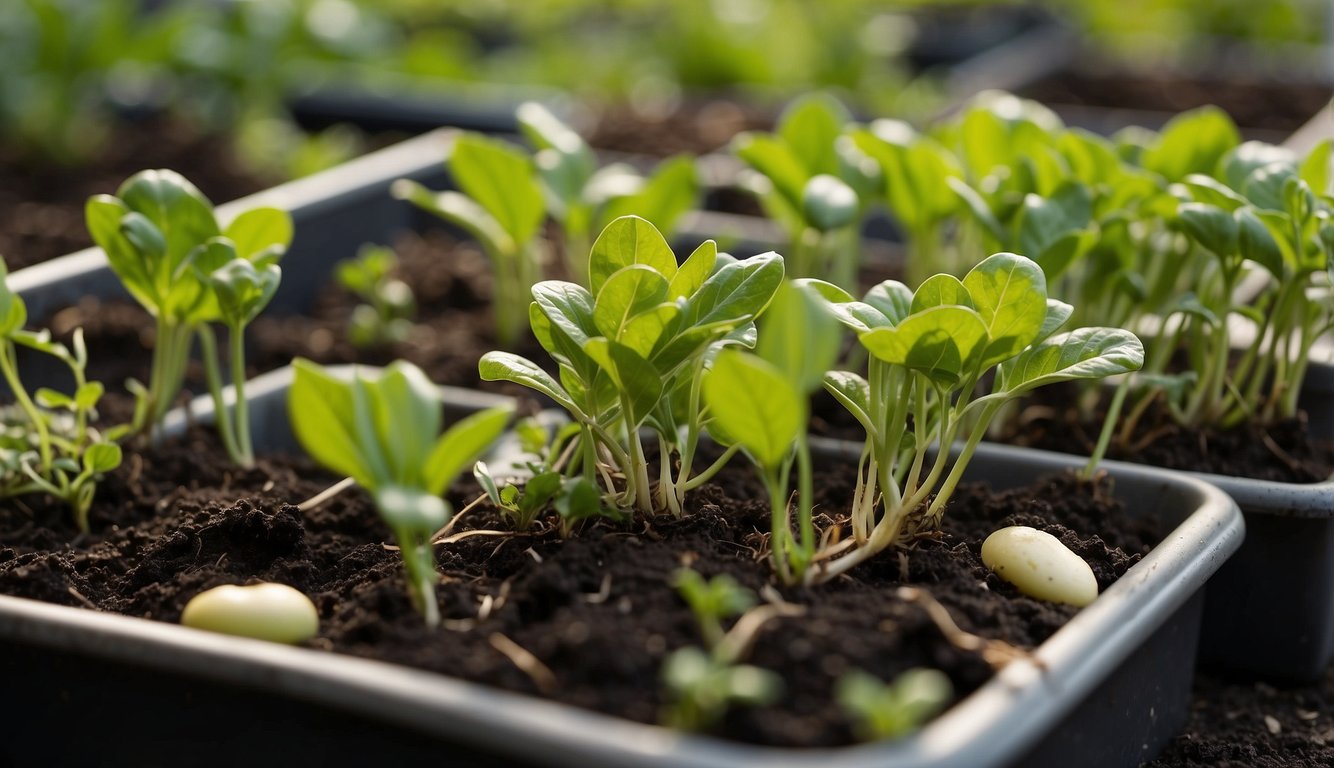Grow from scraps is a fantastic way to reduce food waste and save money on groceries. With a bit of knowledge and effort, you can turn fruit and vegetable scraps into fresh produce. It’s a fun and rewarding way to get more out of your food and reduce your environmental impact.
There are many different types of fruits and vegetables that can be regrown from scraps, including lettuce, celery, onions, and potatoes. The process of regrowing these plants is simple and can be done with basic household items like a glass of water or a pot of soil. By following a few simple steps, you can turn your kitchen scraps into a thriving garden of fresh produce.
Whether you’re an experienced gardener or just starting out, regrowing plants from scraps is a great way to get more out of your food and reduce your environmental impact. With a little bit of knowledge and effort, you can turn your kitchen scraps into a source of fresh produce that will save you money and reduce your carbon footprint.
Getting Started with Scrap Gardening
Understanding Scrap Gardening
Scrap gardening is a sustainable and cost-effective way to grow your own produce from kitchen scraps. It involves re-growing vegetables and fruits from the leftover scraps that would otherwise be thrown away. With a little patience and the right tools, you can turn your kitchen scraps into a thriving garden.
One of the key benefits of scrap gardening is that it is an eco-friendly way to reduce waste. Instead of throwing away food scraps, you can recycle them by growing new produce. This not only saves money on groceries but also reduces the amount of waste that ends up in landfills.
Essential Tools and Materials – Grow from Scraps
To get started with scrap gardening, you’ll need a few essential tools and materials. These include:
- Soil: You’ll need a good quality soil that is rich in nutrients and drains well. Look for soil that is specifically designed for growing vegetables and fruits.
- Water: Plants need water to grow, so make sure you have a reliable source of water. Consider using a watering can or a hose with a spray nozzle to water your plants.
- Containers: You can use a variety of containers to grow your plants, including pots, buckets, and even old food containers. Just make sure they have drainage holes to prevent water from pooling.
- Composting: Composting is an important part of scrap gardening. You can create your own compost bin using kitchen scraps and yard waste. Compost adds nutrients to the soil and helps your plants grow.
In addition to these essential tools and materials, you’ll also need to choose the right scraps to grow. Some good options include lettuce, celery, onions, and potatoes. Just make sure you follow the proper steps for each type of scrap to ensure successful growth.
Overall, scrap gardening is a fun and rewarding way to grow your own produce while reducing waste. With a little effort and the right tools, you can turn your kitchen scraps into a thriving garden.
Regrowing Vegetables from Scraps – Grow from Scraps

As someone who loves gardening and hates waste, I’m always looking for ways to regrow vegetables from scraps. Not only is it a great way to reduce food waste, but it’s also a great way to save money on groceries and have a fresh supply of produce at home. Here are some of my favorite vegetables to regrow from scraps.
Leafy Greens and Lettuce
Lettuce and other leafy greens are some of the easiest vegetables to regrow from scraps. Simply cut off the bottom of the lettuce head, leaving about an inch of stem attached. Place the stem in a bowl of water and set it in a sunny spot. After a few days, you should start to see roots and new leaves forming. Once the roots are a few inches long, you can transplant the lettuce into soil.
Root Vegetables and Tubers – Grow from Scraps
Root vegetables like celery, potatoes, and sweet potatoes are also great candidates for regrowing from scraps. To regrow celery, save the bottom of the stalk and place it in a bowl of water. After a few days, you should see new growth emerging from the center. Once the new growth is a few inches tall, you can transplant it into soil.
To regrow potatoes and sweet potatoes, save the sprouts that form on the potatoes. Cut the sprouts off and plant them in soil. Make sure to plant them with the sprout facing up.
Alliums and Aromatic Herbs
Alliums like onions, garlic, and green onions are some of the easiest vegetables to regrow from scraps. To regrow green onions, save the white part of the onion with the roots attached. Place the onion in a jar of water and set it in a sunny spot. After a few days, you should see new growth emerging from the center. Once the new growth is a few inches tall, you can transplant it into soil.
To regrow onions and garlic, save the bottom of the onion or garlic bulb with the roots attached. Plant the bulb in soil with the roots facing down. Aromatic herbs like basil, mint, and cilantro can also be regrown from scraps. Simply cut off a stem with a few leaves attached and place it in a jar of water. Once roots start to form, you can transplant the stem into soil.
Regrowing vegetables from scraps is a fun and easy way to reduce food waste and save money on groceries. With a little bit of patience and know-how, you can have a fresh supply of produce at home all year round.
Fruits and Other Plants – Grow from Scraps

As I mentioned earlier, regrowing fruits and vegetables from scraps is an eco-friendly and cost-effective way to reduce food waste. Let’s take a look at some fruits and other plants that you can regrow from scraps.
Regrowing Fruits – Grow from Scraps
One of the easiest fruits to regrow from scraps is pineapple. Simply cut off the top of a pineapple and plant it in soil. In a few months, you’ll have a new pineapple plant. You can also regrow strawberries from their runners. Just snip off a runner that has a baby plant attached to it and plant it in soil.
Avocado is another fruit that can be regrown from scraps. Take the pit from an avocado, wash it, and then suspend it over a glass of water using toothpicks. The pit should be partially submerged in the water. After a few weeks, you should see roots and a stem sprouting from the pit. Once the stem has grown to about six inches, plant it in soil.
Herbs and Flavorful Greens
Many herbs and flavorful greens can also be regrown from scraps. Basil, cilantro, mint, rosemary, and thyme are all examples of herbs that can be regrown from cuttings. Simply cut off a stem of the herb, remove the lower leaves, and place the stem in a glass of water. Once roots have formed, plant the stem in soil.
Lettuce and other leafy greens can also be regrown from scraps. Cut off the bottom of the lettuce or green and place it in a shallow dish of water. Change the water every few days and after a week or two, you should see new leaves sprouting from the center of the plant. Once the new leaves have grown to a decent size, you can transplant the plant into soil.
Overall, regrowing fruits and other plants from scraps is a simple and rewarding way to reduce your food waste while also providing your family with fresh produce.
Caring for Your Scrap Garden – Grow from Scraps

Growing a garden from kitchen scraps can be a fun and rewarding experience. However, just like any other garden, it requires proper care and attention to thrive. In this section, I will cover the key aspects of caring for your scrap garden.
Watering and Light Requirements – Grow from Scraps
Water is essential for the growth and development of plants. It is important to water your scrap garden regularly, but not too much. Overwatering can lead to root rot and other problems. The frequency of watering depends on the type of plant, the climate, and the soil. As a general rule, it is better to water deeply and less frequently than to water shallowly and often.
Sunlight is also crucial for the growth of plants. Most plants require at least 6 hours of direct sunlight per day. However, some plants can tolerate partial shade. It is important to choose the right location for your scrap garden based on the amount of sunlight it receives. If your garden does not receive enough sunlight, you can use grow lights to supplement natural light.
Soil Nutrition and Fertilization
The soil is the foundation of your garden. It provides nutrients and support for your plants. It is important to use high-quality soil that is rich in organic matter. You can also add compost or other organic fertilizers to improve soil fertility.
Fertilization is also important for the growth of plants. However, it is important to use the right type and amount of fertilizer. Too much fertilizer can burn the roots of your plants and damage the soil. You can use organic or synthetic fertilizers depending on your preference.
Pest Management and Disease Control – Grow from Scraps
Pests and diseases can damage your scrap garden and reduce your harvest. It is important to monitor your garden regularly for signs of pests and diseases. You can use natural or synthetic pesticides to control pests. However, it is important to use them sparingly and follow the instructions carefully.
Diseases can also be prevented by practicing good garden hygiene. This includes removing dead or diseased plants, cleaning your tools, and rotating your crops. If you notice any signs of disease, it is important to take action immediately to prevent it from spreading to other plants.
Caring for your scrap garden requires attention to watering, light, soil nutrition, fertilization, pest management, and disease control. By following these guidelines, you can ensure that your scrap garden thrives and produces a bountiful harvest.
Harvesting and Using Regrown Produce

Harvesting Tips for Best Yield – Grow from Scraps
When regrowing produce from scraps, it’s important to know when and how to harvest for the best yield. Here are some tips to keep in mind:
- Leafy greens like lettuce and bok choy can be harvested once the leaves are big enough to use. Cut the leaves off at the base, leaving the roots intact. The plant will continue to regrow new leaves for future harvests.
- Root vegetables like carrots, turnips, and beets can be harvested once they have regrown new leaves. Carefully dig up the plant, being careful not to damage the roots. Cut off the leaves and use the root as desired.
- Herbs like basil, mint, and cilantro can be harvested as soon as they have regrown enough new leaves. Cut off the stems just above a set of leaves, leaving enough of the plant intact for future growth.
Creative Uses for Regrown Foods
Regrown produce is not only tasty but also a great way to reduce food waste and enjoy fresh, nutritious food. Here are some creative uses for regrown foods:
- Salads: Freshly harvested lettuce and other leafy greens make a great base for salads. Add in other veggies like tomatoes, cucumbers, and carrots for a colorful and nutritious meal.
- Soups: Root vegetables like carrots and turnips can be used in soups to add flavor and nutrition. Simply chop them up and add them to your favorite soup recipe.
- Tasty snacks: Use herbs like basil and mint to make flavorful dips and spreads. Simply blend the herbs with some olive oil, garlic, and other seasonings for a delicious and nutritious snack.
By following these tips and getting creative with your regrown produce, you can enjoy fresh, tasty food while reducing food waste.
Advanced Techniques and Tips – Grow from Scraps

Propagating Plants for Greater Yield – Grow from Scraps
One of the most effective ways to grow more plants from scraps is by propagating them. Propagation involves taking stem cuttings from the parent plant and rooting them in soil or water. This technique is particularly useful for plants such as herbs, tomatoes, and peppers. To propagate a plant, first, cut a stem from the parent plant at a 45-degree angle. Then, remove the lower leaves from the stem and dip the cut end in rooting hormone powder. Finally, plant the stem in a container filled with moist soil or place it in a jar of water. Keep the soil or water moist and wait for roots to form before transplanting the new plant to a larger container or garden bed.
Maximizing Small Spaces
If you have limited space, you can still grow plants from scraps by using containers. Containers come in various sizes and shapes, making them ideal for growing root crops and leafy greens. When using containers, make sure to choose a size that is appropriate for the plant you want to grow. For example, a shallow container is suitable for growing lettuce, while a deeper container is ideal for growing carrots. Additionally, consider using vertical space by hanging containers or using a trellis to support climbing plants such as tomatoes and cucumbers.
To maximize your small space, consider companion planting. Companion planting involves growing two or more plants together that benefit each other. For example, planting basil with tomatoes can improve the flavor of the tomatoes and repel pests. Similarly, planting marigolds with vegetables can deter pests and attract pollinators. By using these techniques, you can grow a variety of plants in a small space and increase your yield.
Propagating plants and maximizing small spaces are two advanced techniques that can help you grow more plants from scraps. By using containers, companion planting, and other tips, you can increase your yield and enjoy fresh produce all year round.
Sustainability and Environmental Benefits – Grow from Scraps

Reducing Food Waste through Scrap Gardening – Grow from Scraps
As a proponent of sustainable living, I am always looking for ways to reduce my environmental impact. One way I have found to do this is through scrap gardening. Instead of throwing away food scraps and organic waste, I use them to grow new plants. This not only reduces the amount of waste I produce but also saves me money on produce I would have otherwise bought.
By regrowing fruits and vegetables from scraps, I am able to reduce the amount of food waste that ends up in landfills. According to the Environmental Protection Agency, food waste is the single largest type of waste that Americans throw away, accounting for more than 20% of the waste stream. By using food scraps to grow new plants, I am able to divert some of this waste from landfills and turn it into something useful.
The Role of Scrap Gardening in Sustainable Living
Scrap gardening is just one way to live a more sustainable lifestyle. By reducing food waste and composting, we can help to reduce greenhouse gas emissions and protect the environment. Composting food scraps and other organic waste helps to create nutrient-rich soil that can be used to grow new plants, reducing the need for chemical fertilizers and other harmful chemicals.
In addition to reducing waste and protecting the environment, scrap gardening can also save you money. By growing your own produce from scraps, you can reduce your grocery bill and save money on produce that you would have otherwise bought. Plus, you can be sure that your produce is fresh and free from harmful chemicals.
Scrap gardening is a simple and effective way to reduce food waste, save money, and live a more sustainable lifestyle. By using food scraps to grow new plants, we can reduce our environmental impact and help to protect the planet for future generations.
Grow from Scraps: A Herbalist’s Guide
I’m thrilled to share how growing plants from scraps can be a game-changer for your herbal journey. Let’s dive in!
First off, growing from scraps is a fantastic way to reduce waste and save money. You know those veggie scraps you usually toss? They could be the start of your next herb garden!
Now, how does this tie in with our beloved site, theherbprof.com? Well, it’s simple. Our site is a treasure trove of herbal wisdom, and growing your own herbs only enhances that experience.
Imagine this: You’re reading about the benefits of rosemary on our site. Now, instead of just reading, you could be growing your own rosemary from that sprig left over from last night’s dinner. It’s hands-on learning at its finest!
And let’s not forget the joy of watching something grow. There’s a certain thrill in seeing your kitchen scraps transform into lush, green plants. It’s like your very own botanical magic show!
So, are you ready to embrace the wonderful world of growing from scraps? Your journey as an eco-friendly herbalist starts now. Remember, every little sprout counts!
References – Grow from Scraps
Little Herb Encyclopedia, by Jack Ritchason; N.D., Woodland Publishing Incorporated, 1995
The Ultimate Healing System, Course Manual, Copyright 1985, Don Lepore
Planetary Herbology, Michael Tierra, C.A., N.D., Lotus Press, 1988
Handbook of Medicinal Herbs, by James A. Duke, Pub. CRP Second Edition 2007
The Complete Medicinal Herbal, by Penelope Ody, Published by Dorling Kindersley
Check the Following Articles!
Planting Mint from Cuttings: A Simple Guide
Are All Hibiscus Flowers Edible? A Comprehensive Guide
Potato Containers: The Best Options for Storing Your Spuds
Frequently Asked Questions – Grow from Scraps

What vegetables can I regrow indoors from leftover cuttings?
You can regrow several vegetables indoors from leftover cuttings, including lettuce, celery, green onions, and herbs like basil, mint, and cilantro. These vegetables can be regrown in water or soil, depending on the plant’s requirements.
Which fruits are capable of being cultivated from their remains?
Fruits like pineapples, avocados, and lemons can be regrown from their remains. For example, you can regrow a pineapple by planting the top of the fruit in soil, while avocado seeds can be sprouted in water before planting them in soil.
How can I regenerate plants in water using just kitchen scraps?
You can regenerate plants in water using kitchen scraps by placing the cuttings in a container filled with water. Change the water every few days to prevent bacteria growth and ensure the cuttings have enough nutrients to grow. Once the roots have formed, you can transplant the cuttings into soil.
What are the steps to successfully regrow lettuce from its remains?
To regrow lettuce from its remains, place the stem in a container filled with water and place it in a sunny spot. Change the water every few days and wait for new leaves to emerge. Once the new leaves have grown, you can transplant the lettuce into soil.
Can food waste be composted directly into the garden for plant regrowth?
Yes, food waste can be composted directly into the garden to promote plant regrowth. Composting food waste adds valuable nutrients to the soil, which can help plants grow healthier and stronger.
What are the best practices for propagating vegetables from cuttings?
The best practices for propagating vegetables from cuttings include selecting healthy cuttings, using clean tools, and providing the cuttings with enough water and sunlight. It’s also important to be patient and wait for the cuttings to develop roots before transplanting them into soil.

